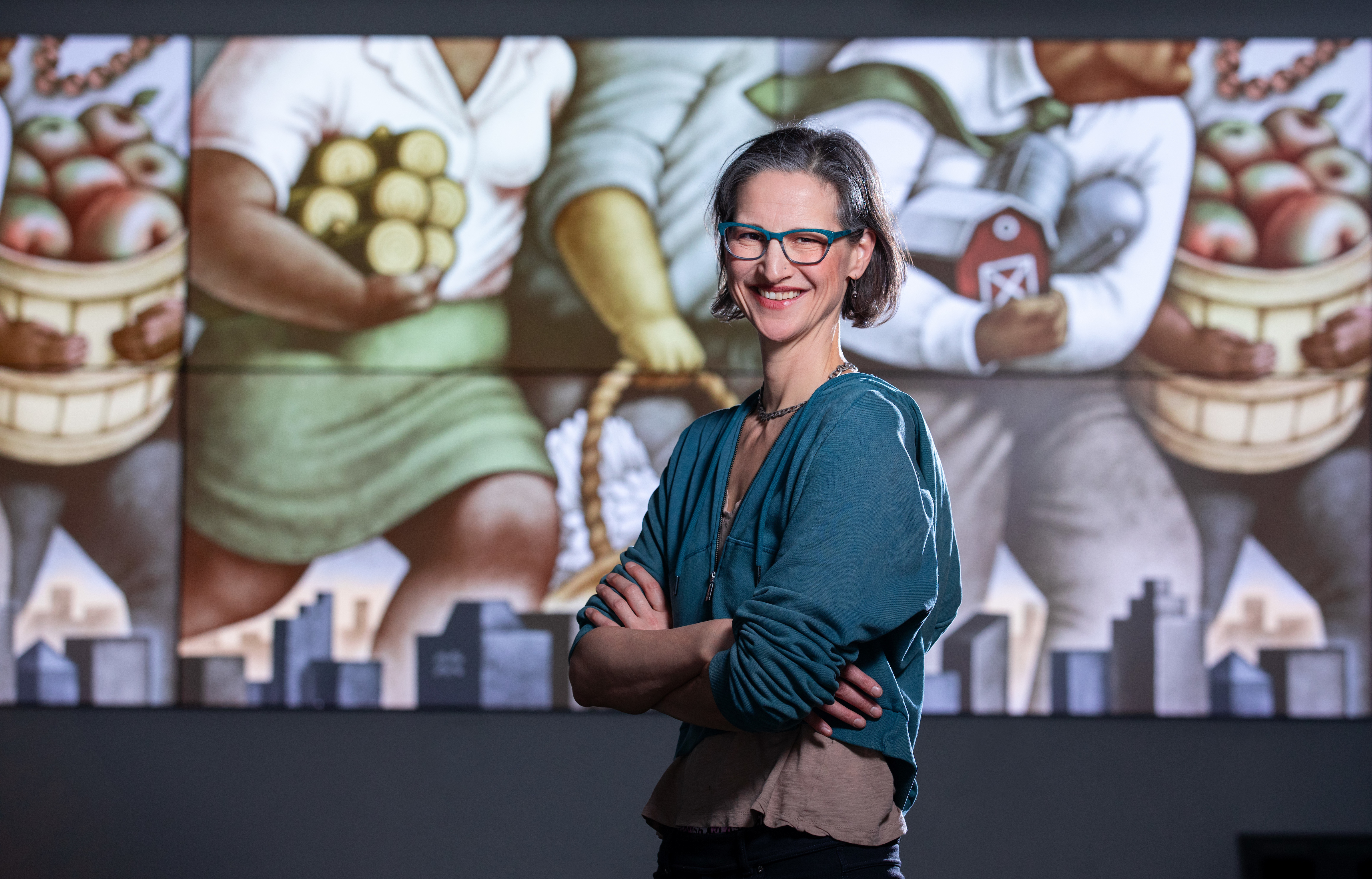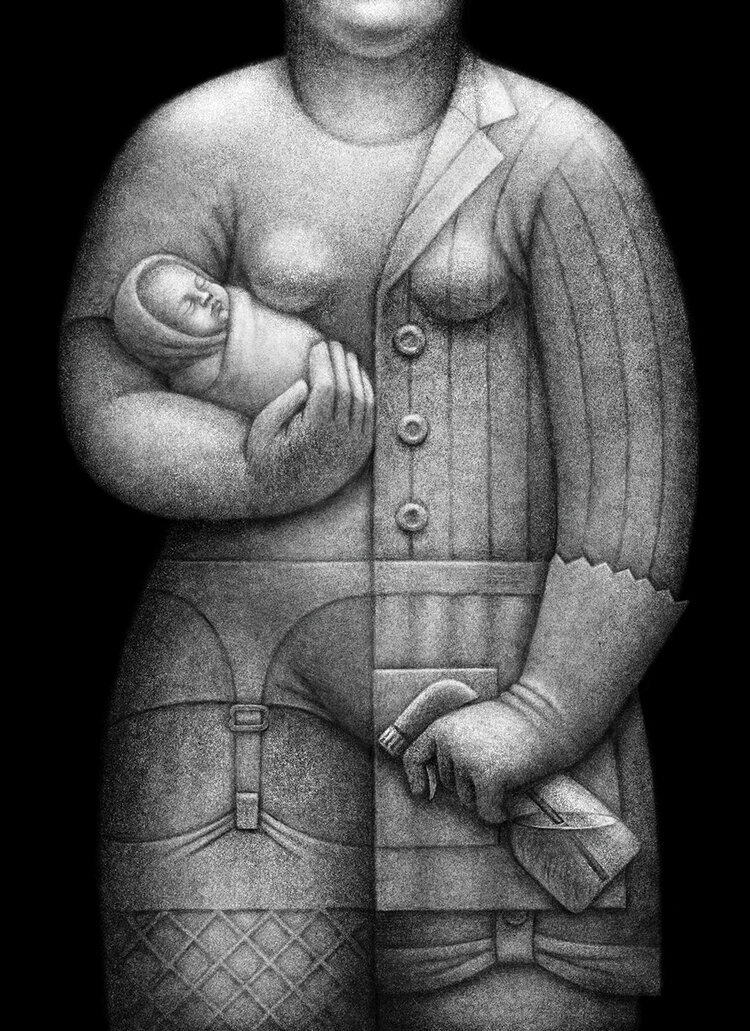
Miriam Martincic, with one of her works behind her, has become an in-demand illustrator, which informs the process she teaches students in the classroom. Photo by Christopher Gannon. Larger image.
AMES, Iowa – Miriam Martincic persevered through plenty of rejection when she began submitting her original illustrations for competitions and publication. Attempt after attempt resulted in a pass – assuming she got any response at all. Then something changed.
Suddenly, her illustrations are appearing everywhere, from Scientific American to The New York Times. She’s amassed an impressive portfolio of publications and competition medals, and now the assistant teaching professor of graphic design passes the hard-won lessons she learned to Iowa State University students.
“The process that I use as a freelance illustrator is the exact same process I teach in the classroom,” Martincic said. “I have to work with art directors to go from a rough sketch to a finished piece, and what we do in class is literally the same thing you do out there in the world of professional illustration.”
A professional illustrator, with detours in sculpture and graphic design
Martincic typically uses digital technology to render her illustrations, drawing on her tablet using a drawing app. Despite their creation in the realm of zeros and ones, the illustrations often retain a physical heft, as if her figures were carved out of heavy material.

Martincic's "Having It All"
Take her illustration titled “Having It All,” for example. The illustration depicts the “multiple and competing expectations of women” and won a gold medal in 2020 from the Society of Illustrators in New York. The image shows the figure of a woman’s body divided into sections by straight lines and right angles. The subject’s right arm cradles an infant; her left hand is covered in a rubber glove and clutches a spray bottle of cleaning liquid. The left side of her torso is clothed in a pinstriped professional suit jacket while her lower body sports lingerie. The entire figure is colored gray and has the texture of stone, giving the sense this is an image of a statue more than a flesh-and-blood human being. Martincic said that’s a hallmark of her style, due in part to her training in sculpture.
Originally from Cleveland, Martincic grew up with a passion for drawing. She attended Columbus College of Art and Design in Columbus, Ohio, where she majored in fine art with an emphasis on stone carving and oil painting. She considered studying illustration during college, but she found fine art captured her creative spirit. She completed a master’s in sculpture at Ohio University and spent the next several years teaching and working as a gallery artist before finding herself drawn to graphic design. After several years as a graphic designer, she suspected illustration might offer her a way to combine her training and experience with fine art, branding and graphic design.
“Illustration can blend graphic design and fine art in some really interesting ways, so I decided this was where I should be,” she said. “It was a great match for my skill set and experiences.”
Just one problem. She’d never published an illustration before. So she spent years honing her skills, submitting her work and getting rejection emails. She landed at Iowa State in 2019 to teach graphic design, and it was around then that she used a professional development opportunity to take illustration courses online. Those courses proved to be a turning point in her story, Martincic said.
The courses taught her about industry expectations and standard processes, and she made connections with art directors and others in the illustration industry. Things started to click. Soon, Martincic had been commissioned by The New York Times, Scientific American, Harper’s, The Wall Street Journal and other big-name publications. These were primarily editorial illustrations, or artwork designed to accompany text stories that appear in print. But she’s also illustrated for books and corporate materials, and she’s branching out into lettering and pattern-making, a natural fit for her graphic design background. The patterns she designs can be used for textiles, wallpaper, packaging and a number of other possibilities.
But what kept her going through four years of steady rejection, when landing jobs like that seemed like wishful thinking? Martincic credits her years as a swimmer for teaching her the importance of practice and resilience. She began swimming at a young age and competed in high school. Today, she swims on a master’s team and routinely begins her day in the pool with an early morning workout.
The lessons she learned as a competitive swimmer influenced her approach to illustration, she said.
“I’m going to get up and practice every day. That feels natural to me,” she said. “I’m a believer in practice, and I’m a believer in trying again.”
Teaching the process to students
Martincic said the lessons she’s learned as a freelance illustrator translate directly to the classroom, where she teaches a graphic design studio course on illustration. Martincic gives students broad prompts similar to what art directors for major publications use when working with illustrators. Martincic’s students then go through the process of forming multiple concepts that might fit the prompt, sketching thumbnails of multiple ideas, winnowing their concepts down to the best ideas and finally creating a fully illustrated piece.
Along the way, students meet in small groups to brainstorm and ask questions with one another, with each student taking on the role of an art director for other students in the group. The process shows students how to generate ideas and then choose the best option, an essential skill for professional illustrators. And Martincic’s experience means she can offer firsthand insight into what illustrators need to keep in mind as they communicate with clients to create images that work for the job.
The interaction between art directors and the illustrators is a critical skill, one Martincic has developed in her freelance work and stresses in her studio.
“Miriam was highly communicative and provided a variety of polished sketch options, which gave a sense of the possibilities for the complete package,” said Harper’s Magazine Art Director Kathryn Humphries about working with Martincic. “Her strengths as an illustrator are both conceptual and technical — our collaboration was seamless from start to finish.”
Martincic said she enjoys the energy and creativity of her students as they explore the illustration process.
“I love the balance of teaching and illustrating. I just feel like every day I have something new to bring to class,” Martincic said.